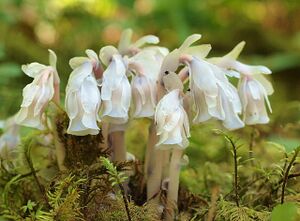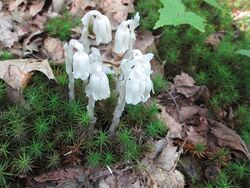Ghost Pipe plant: Difference between revisions
No edit summary |
No edit summary |
||
| (13 intermediate revisions by the same user not shown) | |||
| Line 1: | Line 1: | ||
''Monotropa uniflora'', more commonly known as Ghost Pipe or Indian Pipe, is a unique perennial plant. This plant is non-photosynthetic with a white and waxy appearance, causing it to commonly be mistaken for a fungi [1]. | ''Monotropa uniflora'', more commonly known as Ghost Pipe or Indian Pipe, is a unique perennial plant. This plant is non-photosynthetic with a white and waxy appearance, causing it to commonly be mistaken for a fungi [1]. | ||
[[File:Monotropa uniflora (10180105674).jpg|Monotropa_uniflora_(10180105674)|thumb|right|Ghost pipe plant.]] | |||
| Line 26: | Line 27: | ||
| Monotropa | | Monotropa | ||
| M. uniflora | | M. uniflora | ||
|} [2] | |}[2] | ||
Ghost pipe was formerly considered to be part of the Ericaceae family, but most recent evidence now puts it in the Monotropaceae family [3]. | Ghost pipe was formerly considered to be part of the Ericaceae family, but most recent evidence now puts it in the Monotropaceae family [3]. | ||
| Line 33: | Line 34: | ||
==Description== | ==Description== | ||
[[File: Monotropa uniflora Summer 2013.jpg| | [[File:Monotropa uniflora Summer 2013.jpg|250px|thumb|Monotropa uniflora Summer 2013|thumb|right|Photo of Ghost Pipe cluster on forest floor.]] | ||
Ghost pipe plants are perennials that grow in small clusters on the forest floor [5]. They have a stem, with scale-like leaves that grow about 10 - 30 cm tall and on top, curves downward into a white, five parted flower [3]. As the plant ages, the stalk will straighten and the flowers will point upwards. The ghost pipe plant is one of approximately 3000 species that does not contain chlorophyll, which is what gives it the white, translucent coloring [4]. Because it lacks chlorophyll, it does not carry out photosynthesis and is considered to be a saprophyte [1]. "It parasitizes parasitic tree fungi" and has been known to form associations with more than a dozen different types of fungi [4]. | Ghost pipe plants are perennials that grow in small clusters on the forest floor [5]. They have a stem, with scale-like leaves that grow about 10 - 30 cm tall and on top, curves downward into a white, five parted flower [3]. As the plant ages, the stalk will straighten and the flowers will point upwards. The ghost pipe plant is one of approximately 3000 species that does not contain chlorophyll, which is what gives it the white, translucent coloring [4]. Because it lacks chlorophyll, it does not carry out photosynthesis and is considered to be a saprophyte [1]. "It parasitizes parasitic tree fungi" and has been known to form associations with more than a dozen different types of fungi [4]. | ||
[[File: | |||
[[File:RockyMountainsLocatorMap.png|RockyMountainsLocatorMap|200px|thumb|left|Ghost pipe does not generally grow in "red" areas.]] | |||
==Habitat & Range== | ==Habitat & Range== | ||
''Monotropa uniflora'' is native to North America and is found throughout the country (excluding the Rocky Mountain area) and can also be found in Asia [3], Russia and northern South America [5]. Ghost pipe prefers to live in woodland [[humus]] [2] and likes rich, moist [[soil]]. It is found mostly in shaded areas where other green plants cannot live, as it does not require the sun for photosynthesis [4]. | ''Monotropa uniflora'' is native to North America and is found throughout the country (excluding the Rocky Mountain area) and can also be found in Asia [3], Russia and northern South America [5]. Ghost pipe prefers to live in woodland [[humus]] [2] and likes rich, moist [[soil]]. It is found mostly in shaded areas where other green plants cannot live, as it does not require the sun for photosynthesis [4]. | ||
| Line 47: | Line 50: | ||
==Uses== | ==Uses== | ||
[[File: Monotropa uniflora L. | [[File:Monotropa uniflora L. - Indian Pipe, Ghost-flower (16891627057).jpg|Monotropa_uniflora_L._-_Indian_Pipe,_Ghost-flower_(16891627057)|100px|thumb|right|]] | ||
Ghost pipe has traditionally been used in many ways to aid in human health. The herbal actions of ''Monotropa uniflora'' include nervine, anodyne, diaphoretic, sedative, and antispasmodic. A tincture can be made to ease pain, both physical and emotional and has been recommended as an alternative to opiates[5]. It has been used as a remedy for spasms and to help children who suffer from epilepsy or fits. It is known to calm nerves and restlessness and assists symptoms of PTSD. The flowers can be chewed to help with toothaches and an infusion of the leaves used to treat colds and fevers. The entire plant is edible, but remains tasteless unless cooked, in which case tastes like asparagus [4]. | Ghost pipe has traditionally been used in many ways to aid in human health. The herbal actions of ''Monotropa uniflora'' include nervine, anodyne, diaphoretic, sedative, and antispasmodic. A tincture can be made to ease pain, both physical and emotional and has been recommended as an alternative to opiates[5]. It has been used as a remedy for spasms and to help children who suffer from epilepsy or fits. It is known to calm nerves and restlessness and assists symptoms of PTSD. The flowers can be chewed to help with toothaches and an infusion of the leaves used to treat colds and fevers. The entire plant is edible, but remains tasteless unless cooked, in which case tastes like asparagus [4]. | ||
Latest revision as of 13:17, 8 May 2022
Monotropa uniflora, more commonly known as Ghost Pipe or Indian Pipe, is a unique perennial plant. This plant is non-photosynthetic with a white and waxy appearance, causing it to commonly be mistaken for a fungi [1].

Taxonomy
| Kingdom | Phylum | Class | Order | Family | Genus | Species | |
|---|---|---|---|---|---|---|---|
| Classification | Plantae | Angiosperms | Eudicots | Ericales | Ericaceae | Monotropa | M. uniflora |
[2]
Ghost pipe was formerly considered to be part of the Ericaceae family, but most recent evidence now puts it in the Monotropaceae family [3].
Description

Ghost pipe plants are perennials that grow in small clusters on the forest floor [5]. They have a stem, with scale-like leaves that grow about 10 - 30 cm tall and on top, curves downward into a white, five parted flower [3]. As the plant ages, the stalk will straighten and the flowers will point upwards. The ghost pipe plant is one of approximately 3000 species that does not contain chlorophyll, which is what gives it the white, translucent coloring [4]. Because it lacks chlorophyll, it does not carry out photosynthesis and is considered to be a saprophyte [1]. "It parasitizes parasitic tree fungi" and has been known to form associations with more than a dozen different types of fungi [4].

Habitat & Range
Monotropa uniflora is native to North America and is found throughout the country (excluding the Rocky Mountain area) and can also be found in Asia [3], Russia and northern South America [5]. Ghost pipe prefers to live in woodland humus [2] and likes rich, moist soil. It is found mostly in shaded areas where other green plants cannot live, as it does not require the sun for photosynthesis [4].

Uses

Ghost pipe has traditionally been used in many ways to aid in human health. The herbal actions of Monotropa uniflora include nervine, anodyne, diaphoretic, sedative, and antispasmodic. A tincture can be made to ease pain, both physical and emotional and has been recommended as an alternative to opiates[5]. It has been used as a remedy for spasms and to help children who suffer from epilepsy or fits. It is known to calm nerves and restlessness and assists symptoms of PTSD. The flowers can be chewed to help with toothaches and an infusion of the leaves used to treat colds and fevers. The entire plant is edible, but remains tasteless unless cooked, in which case tastes like asparagus [4].
References
[1] “Indian Pipe (Monotropa Uniflora) Species Page.” http://www.bio.brandeis.edu/fieldbio/Wildflowers_Kimonis_Kramer/PAGES/INDIANPIPE_PAGE_FINAL.html.
[2] “Ghost Pipes (Monotropa Uniflora) - JungleDragon.” https://www.jungledragon.com/specie/1379/ghost_pipes.html.
[3] “Ghost Pipe.” https://www.fs.fed.us/wildflowers/plant-of-the-week/monotropa_uniflora.shtml.
[4] “Ghost Pipe Facts and Health Benefits,” September 19, 2018. https://www.healthbenefitstimes.com/ghost-pipe/.
[5] Wisdom of the Plant Devas. “Ghost Pipe: A Hauntingly Rare Plant for Physical and Emotional Pain,” October 4, 2019. https://wisdomoftheplantdevas.com/2019/10/04/ghost-pipe-a-hauntingly-rare-plant-for-physical-and-emotional-pain/.